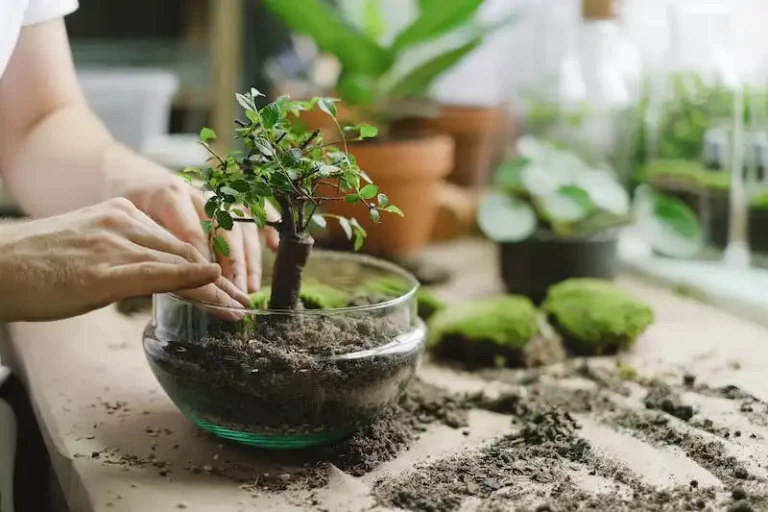Jade plants are commonly affected by mealybugs, which are small insects that feed on the plant’s juices and leave a sticky, protective residue on the leaves. Mealybugs can be a real nuisance, especially when they infest the plant indoors. In this guide, we will show you how to get rid of mealybugs on your jade plant and prevent them from spreading.
One effective way to treat mealybug infestation is by using oil. Our first recommendation is to use a horticultural oil or insecticidal soap to suffocate the mealybugs. Be sure to follow the instructions on the packaging for the best results. You can also dab the affected areas with rubbing alcohol to kill the pests. However, be careful not to soak the plant to avoid overwatering, as jade plants are usually susceptible to root rot.
Another option is to introduce beneficial predators, such as ladybugs or predatory beetles, to feed on the mealybugs. These natural enemies can help keep the population under control. Additionally, you can improve the plant’s overall health by providing adequate drainage and avoiding overwatering. Mealybugs are more likely to infest plants that are stressed or weakened.
If the infestation is severe and the above methods do not work, you may need to completely remove and discard the affected plant parts. Just be sure to clean any tools or surfaces that come in contact with the infested plant to prevent the spread of mealybugs to other plants. In extreme cases, you may need to consider buying a new jade plant to start fresh and avoid any future re-infestations.
Remember, prevention is key when it comes to dealing with mealybugs. Regularly inspect your jade plant for any signs of infestation, such as a sticky residue or the presence of mealybugs themselves. Keep the plant clean by wiping down the leaves and removing any debris or dead insects. Avoid overwatering and maintain adequate air circulation to prevent fungal infections. By following these steps, you can keep your jade plant healthy and mealybug-free.
Dealing with mealy bug infestation on jades
Gardeners often face the challenge of dealing with mealy bug infestations on their jade plants. These small, white insects can wreak havoc on the health and appearance of the plants if not addressed promptly. Here are some effective ways to combat and get rid of mealy bugs:
1. Prevention is the best measure: Regularly inspect your plants for any signs of mealy bugs. If you notice any, take immediate action to prevent the infestation from spreading.
2. Improve air circulation and drainage: Mealy bugs thrive in humid environments. Ensure that your jade plant has adequate airflow and proper drainage to discourage their growth.
3. Use natural remedies: There are several natural remedies you can try to get rid of mealy bugs. For instance, using a mixture of soapy water (preferably black soap) can help eliminate them. Simply spray the solution onto the affected areas of the plant.
4. Introduce beneficial insects: Ladybugs and lacewings are natural predators of mealy bugs. You can release these insects in your garden or near your jade plant to help control the infestation.
5. Use insecticides as a last resort: If the infestation is severe and other methods have failed, you may need to use insecticides. However, make sure to choose one specifically formulated for mealy bugs and follow the instructions carefully.
6. Keep the humidity in check: Mealy bugs thrive in high humidity conditions. By maintaining moderate humidity levels, you can discourage their growth and make your jade plant less susceptible to infestation.
7. Quarantine infested plants: If you have multiple plants, it’s crucial to quarantine those infested with mealy bugs. This will prevent the infestation from spreading to healthy plants.
8. Avoid overwatering: Mealy bugs are attracted to moisture and overwatering can create an ideal environment for them. Avoid overwatering your jade plant and ensure the soil is well-drained.
9. Seek professional help if needed: If the mealy bug infestation persists or worsens despite your efforts, consider seeking help from a professional pest control service. They will be able to provide expert advice and treatments.
In conclusion, dealing with mealy bug infestation on jades requires a combination of preventive measures, natural remedies, and, if necessary, the use of insecticides. By being proactive and taking appropriate action, you can keep your jade plant healthy and mealy bug-free.
3 Answers 3
When dealing with mealybugs on jade plants, there are several methods you can try to get rid of them. Here are three possible approaches:
1. Natural and Organic Solutions: If you prefer a more natural approach, there are several options available. One effective method is introducing natural predators that feed on mealybugs, such as ladybugs or lacewings. You can purchase these beneficial insects online or from a local garden center. Another option is using a mixture of dish soap and water to create a soapy solution. Simply spray the affected areas of the plant, making sure to cover both the leaves and stems. This will help suffocate the mealybugs and control their population. Additionally, neem oil, which is derived from the neem tree, has insecticidal properties and can be used as a foliar spray to treat mealybugs.
2. Insecticides: In more severe cases, where natural and organic solutions may not be effective, using insecticides can be a good option. There are various chemical pesticides available specifically for mealybug control. When using these products, it is important to carefully read and follow the instructions provided by the manufacturer. Be sure to choose a product labeled for use on jade plants, and avoid overusing pesticides, as this can harm the plant and its beneficial insects.
3. Prevention and Maintenance: The best measure to control mealybugs is prevention. Before buying a new jade plant, inspect it thoroughly for any signs of pests or disease. It is also a good idea to quarantine new plants for a few weeks to ensure they are pest-free before introducing them to your collection. Regularly inspect your plants for any signs of mealybugs, such as white, cotton-like clusters on the leaves or stems. If you spot an infestation, take action immediately to prevent it from spreading. Maintain optimal conditions for your jade plants, including proper watering, adequate sunlight, and good air circulation. Avoid overwatering, as this can create favorable conditions for mealybug infestations. Additionally, keep your plants clean by regularly wiping their leaves with a damp cloth to remove any dust or debris that can attract pests. Finally, consider regularly rotating your plants, as mealybugs and their eggs can hide in the soil and on the windowsill. Moving your plants to different locations will help prevent mealybugs from becoming established and spreading.
How To Get Rid Of Mealybugs On Jade Plant
Mealybugs can be a common problem for jade plants, but there are several ways to get rid of them and prevent future infestations. Here are some effective measures you can take:
| 1. Identify the infestation |
| Before you can get rid of mealybugs, you need to know what to look for. Mealybugs are small, oval-shaped insects with a cotton-like or waxy appearance. They often gather in clusters on the leaves and stems of plants. |
| 2. Introduce sticky traps |
| Sticky traps can be a helpful tool in combating mealybug infestations. Place them near your jade plant to catch any mealybugs that may be present. This can help reduce their numbers and prevent them from spreading. |
| 3. Maintain a clean plant surface |
| Regularly cleaning the leaves and stems of your jade plant can prevent mealybugs from finding a suitable surface to feed on. Use a damp cloth or sponge to gently wipe away any dust or debris. |
| 4. Prevent infestation when buying new plants |
| Before introducing a new plant to your collection, thoroughly inspect it for any signs of mealybugs or other pests. Look for cotton-like clusters or bronze-colored scales on the leaves and stems. Quarantine the plant for a few weeks to make sure it’s not carrying any hidden pests before moving it near your jade plant. |
| 5. Use natural predators |
| Introducing natural predators like ladybugs or lacewings can help control mealybug populations. These beneficial insects feed on mealybugs and can significantly reduce their numbers in your garden. |
| 6. Kill them with soap and water |
| A simple solution of water and mild liquid soap can be an effective mealybug killer. Mix a few drops of soap with water in a spray bottle and gently spray the affected areas of your jade plant. Make sure to cover both the upper and lower surfaces of the leaves. |
| 7. Apply neem oil |
| Neem oil is a natural insecticide that can kill mealybugs on contact. Dilute neem oil according to the manufacturer’s instructions and apply it to the infested areas of your jade plant. It can also help prevent future infestations. |
| 8. Optimize humidity and airflow |
| Mealybugs thrive in warm and humid conditions, so optimizing humidity and airflow around your jade plant can make it less favorable for them to survive. Avoid overwatering your plant and ensure good air circulation by placing it near a fan or open windowsill. |
| 9. Deal with the root cause |
| If your jade plant is continuously infested with mealybugs, there may be an underlying issue that is making it susceptible to these pests. Check for problems like overwatering, poor drainage, or unhealthy roots and address them accordingly. |
By following these strategies, you can effectively get rid of mealybugs on your jade plant and maintain a healthy and pest-free plant.
Using Neem Oil
Neem oil is a popular and effective natural remedy for dealing with mealybug infestations on jade plants. Neem oil is derived from the neem tree and is known for its insecticidal and fungicidal properties. It works by suffocating the mealybugs and inhibiting their ability to feed and reproduce.
To use neem oil to get rid of mealybugs on your jade plant, follow these steps:
- Before applying neem oil, it’s important to clean your jade plant and remove any dead or damaged leaves or debris. This will help improve air circulation and reduce the chances of fungal infections.
- Mix neem oil with water according to the instructions on the product label. Typically, a concentration of 2-5% neem oil is recommended.
- Using a clean spray bottle, spray the neem oil solution onto the affected areas of your jade plant, focusing on the areas where mealybugs are commonly found, such as along the stems and on the undersides of leaves.
- You can also use a cotton ball soaked in the neem oil solution to directly apply it to the mealybugs.
- Make sure to cover all parts of the plant, including the leaves, stems, and soil surface. Mealybugs can hide in cracks and crevices, so be thorough in your application.
- Repeat the neem oil treatment every 7-14 days until the mealybug infestation is under control. It may take several treatments to completely eradicate the pests.
- Monitor your jade plant regularly for any signs of mealybug reinfestation. If new mealybugs appear, repeat the neem oil treatment.
- Ensure proper care for your jade plant, including providing adequate sunlight, water, and optimal drainage. A healthy plant is less likely to attract mealybugs or other pests.
Using neem oil is a safe and organic method for getting rid of mealybugs on your jade plant. It is non-toxic to humans and many beneficial insects, making it a preferable choice for gardeners who want to avoid using pesticides. Neem oil is also effective against other common pests, such as aphids and gnats, making it a versatile helper in your garden.


